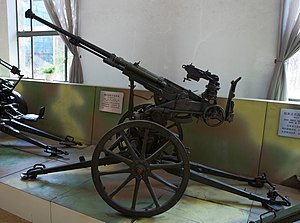Type 98 20 mm AA Machine Cannon
| Type 98 20 mm anti-aircraft machine cannon | |
|---|---|

A Type 98 20 mm cannon at the China People's Revolution Military Museum. Note the gun has no magazine fitted.
|
|
| Type | |
| Place of origin | Japan |
| Service history | |
| In service | 1938–1945 |
| Used by | Japan, Indonesia |
| Wars | World War II, Indonesian National Revolution |
| Production history | |
| Designed | 1933-1938 |
| No. built | 2,500 |
| Specifications | |
| Weight | 373 kg (822 lb) |
| Barrel length | 1.4 m (4 ft 7 in) L/70 |
|
|
|
| Shell | 20×142 mm |
| Caliber | 20 mm (0.79 in) |
| Action | Gas operated |
| Carriage | Two wheeled split trail. |
| Elevation | -5° to +85° |
| Traverse | 360° |
| Rate of fire | 300 rounds/min (maximum) 120 rounds/min (practical) |
| Muzzle velocity | 2,720 ft/s (830 m/s) |
| Maximum firing range | 5,500 m (18,000 ft) (horizontal) 3,500 m (11,500 ft) (altitude) |
| Feed system | 20 round box |
The Type 98 20 mm AA machine cannon was the most common light anti-aircraft gun of the Imperial Japanese Army. The Type 98 designation was given to this gun as it was accepted in the year 2598 of the Japanese calendar (1938). About 80% of IJA light AA guns were Type 98s. It entered service in 1938 and first saw combat in Nomonhan. It was used until the end of World War II. After World War II this gun was used by the Indonesian Army in the Indonesian National Revolution.
The gun could be emplaced in about three minutes by an experienced crew or fired inaccurately from its wheels.
This weapon and its variants were based on the French design of the 13.2 mm Hotchkiss machine gun of the 1930s, which the Japanese forces had bought and further developed at home.
The Type 98 was also one of the two armament options for the IJA's Submersible Gun Mount Model 1.
...
Wikipedia
